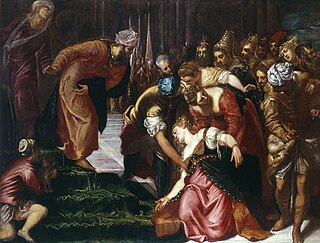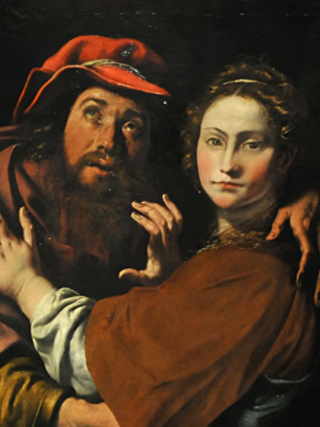
The Book of Esther, also known in Hebrew as "the Scroll", is a book in the third section of the Hebrew Bible. It is one of the Five Scrolls in the Hebrew Bible and later became part of the Christian Old Testament. The book relates the story of a Jewish woman in Persia, born as Hadassah but known as Esther, who becomes queen of Persia and thwarts a genocide of her people.

Esther, originally Hadassah, is the eponymous heroine of the Book of Esther in the Hebrew Bible. According to the biblical narrative, which is set in the Achaemenid Empire, the Persian king Ahasuerus falls in love with Esther and marries her. His grand vizier Haman is offended by Esther's cousin and guardian Mordecai because of his refusal to bow before him; bowing in front of another person was a prominent gesture of respect in Persian society, but deemed unacceptable by Mordecai, who believes that a Jew should only express submissiveness to God. Consequently, Haman plots to have all of Persia's Jews killed, and eventually convinces Ahasuerus to permit him to do so. However, Esther foils the plan by revealing and decrying Haman's plans to Ahasuerus, who then has Haman executed and grants permission to the Jews to take up arms against their enemies; Esther is hailed for her courage and for working to save the Jewish nation from eradication.

Ahasuerus is a name applied in the Hebrew Bible to three rulers of Ancient Persia and to a Babylonian official first appearing in the Tanakh in the Book of Esther and later in the Book of Tobit. It is a transliteration of either Xerxes I or Artaxerxes I; both are names of multiple Achaemenid dynasty Persian kings.

Mordecai is one of the main personalities in the Book of Esther in the Hebrew Bible. He is described in Tanna Devei Eliyahu as being the son of Jair, of the tribe of Benjamin and member of the Sanhedrin. Mordecai was also the cousin and guardian of Esther, who became queen of Persia under the reign of Ahasuerus. Mordecai's loyalty and bravery are highlighted in the story as he helps Esther foil the plot of Haman, the king's vizier, to exterminate the Jewish people. His story is celebrated in the Jewish holiday of Purim, which commemorates his victory. One theory frequently discussed in scholarship suggests that the Book of Esther serves as an etiology for Purim, with Mordecai and Esther representing the Babylonian gods Marduk and Ishtar in a historicized Babylonian myth or ritual.

Purim is a Jewish holiday that commemorates the saving of the Jewish people from annihilation at the hands of an official of the Achaemenid Empire named Haman, as it is recounted in the Book of Esther.
Abagtha was a court official of King Ahasuerus. He is mentioned once in the Book of Esther. According to this narrative, King Ahasuerus commanded Abagtha and six other officials to parade the Queen Vashti before the king and his ministers in the crown jewels. Her refusal led to her demise and the selection of Esther as the new queen of the Persian Empire.

Vashti was a queen of Persia and the first wife of Persian king Ahasuerus in the Book of Esther, a book included within the Tanakh and the Old Testament which is read on the Jewish holiday of Purim. She was either executed or banished for her refusal to appear at the king's banquet to show her beauty as Ahasuerus wished, and was succeeded as queen by Esther, a Jew. That refusal might be better understood via the Jewish tradition that she was ordered to appear naked. In the Midrash, Vashti is described as wicked and vain; she is viewed as an independent-minded heroine in feminist theological interpretations of the Purim story.

Haman is the main antagonist in the Book of Esther, who according to the Hebrew Bible was an official in the court of the Persian empire under King Ahasuerus, commonly identified as Xerxes I but traditionally equated with Artaxerxes I or Artaxerxes II. His epithet, Agagite, indicates that Haman was a descendant of Agag, the king of the Amalekites. Some commentators interpret this descent to be symbolic, due to his similar personality.
According to the biblical book of Esther, Memucan was one of the seven vice-regents of the Persian King Ahasuerus.

Esther was the chief character in the Book of Esther. She is counted among the prophetesses of Israel. Allusions in rabbinic literature to the Biblical story of Esther contain various expansions, elaborations and inferences beyond the text presented in the book of the Bible.

Esther and the King is a 1960 religious epic film produced and directed by Raoul Walsh and starring Joan Collins as Esther, Richard Egan as Ahasuerus, and Denis O'Dea as Mordecai. Walsh and Michael Elkins wrote the screenplay, which was based on the Book of Esther of the Hebrew Bible and the Old Testament. It recounts the origin of the Jewish celebration of Purim.

Rachel was a Biblical figure, the favorite of Jacob's two wives, and the mother of Joseph and Benjamin, two of the twelve progenitors of the tribes of Israel. Rachel's father was Laban. Her older sister was Leah, Jacob's first wife. Her aunt Rebecca was Jacob's mother.

Esther, also known as The Bible: Esther, is a 1999 American-Italian-German television film based on the Book of Esther, directed by Raffaele Mertes and starring Louise Lombard as Queen Esther, F. Murray Abraham as Mordechai, Jürgen Prochnow as Haman, Thomas Kretschmann as King Achashverosh and Ornella Muti as Vashti.

The Toilette of Esther or Esther Preparing to be Presented to King Ahasuerus, is an 1841 oil-on-canvas painting by the French artist Théodore Chassériau. The painting depicts a moment from the scriptural Book of Esther, when Esther prepared to meet King Ahasuerus, ruler of Persia, who subsequently took her as his wife. The painting is in the Musée du Louvre. Vincent Pomarède of the Museum of Fine Arts of Lyon has described it as "one of the most famous (paintings) in the Louvre".

One Night with the King is a 2006 American religious epic film produced by Matt Crouch and Laurie Crouch of Gener8Xion Entertainment, directed by Michael O. Sajbel, and starring Peter O'Toole, Tiffany Dupont, John Rhys-Davies, and Luke Goss.

Esther Before Ahasuerus is a large painting of 1546–47 by the Venetian painter Tintoretto showing a scene from the Greek addition to the Book of Esther, in which Queen Esther faints during a bold intervention with her husband King Ahasuerus of Persia. In oil on canvas, it measures 207.7 by 275.5 centimetres. Since the 1620s it has been in the Royal Collection of the United Kingdom, and in 2019 it hung in the King's Gallery in Kensington Palace, London.

Esther Before Ahasuerus is a painting by the 17th-century Italian artist Artemisia Gentileschi. It shows the biblical heroine Esther going before Ahasuerus to beg him to spare her people. The painting is now in the Metropolitan Museum of Art in New York, having been donated to the museum by Elinor Dorrance Ingersoll in 1969. It is one of Gentileschi's lesser known works, but her use of lighting, characterization, and style help in successfully portraying Esther as a biblical heroine as well as the main protagonist of the work.

Esther 1 is the first chapter of the Book of Esther in the Hebrew Bible or the Old Testament of the Christian Bible. The author of the book is unknown and modern scholars have established that the final stage of the Hebrew text would have been formed by the second century BCE. Chapters 1 and 2 form the exposition of the book. This chapter records the royal banquets of the Persian king Ahasuerus until the deposal of queen Vashti.

Esther 2 is the second chapter of the Book of Esther in the Hebrew Bible or the Old Testament of the Christian Bible. The author of the book is unknown and modern scholars have established that the final stage of the Hebrew text would have been formed by the second century BCE. Chapters 1 and 2 form the exposition of the book. This chapter introduces Mordecai and his adoptive daughter, Esther, whose beauty won the approval of the king Ahasuerus, and she was crowned the queen of Persia. Given information from Mordecai, Esther warned the king of an assassination plan, so that the would-be assassins were executed on the gallows, and the king owed Mordecai his life.

Esther 7 is the seventh chapter of the Book of Esther in the Hebrew Bible or the Old Testament of the Christian Bible, The author of the book is unknown and modern scholars have established that the final stage of the Hebrew text would have been formed by the second century BCE. Chapters 3 to 8 contain the nine scenes that form the complication in the book. This chapter records the second banquet of Esther. The king Ahasuerus was then determined to grant her any request, so Esther spoke out about the death threat on her people and identifies Haman as the perpetrator of the projected genocide. The king went out to his garden in a rage, but shortly came back to see Haman seemingly threatening Esther on her recliner couch. This caused the king to command the hanging of Haman on the very gallows Haman intended for Mordecai.

















